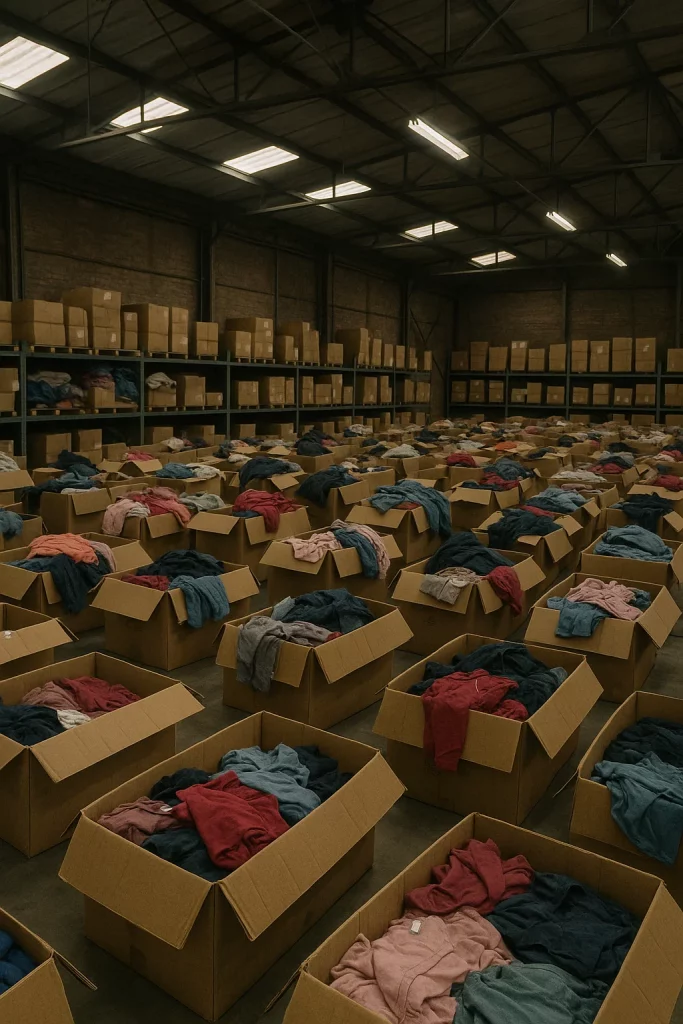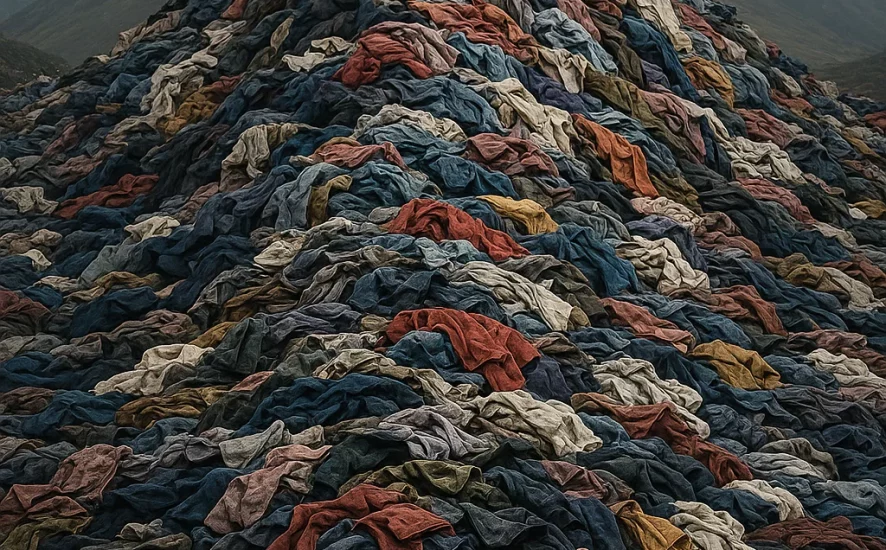Fashion is a multi-billion-pound industry, celebrated for its creativity and innovation. Yet, behind the glitz and glamour lies a dark secret: millions of unsold garments are discarded, burned or destroyed every year due to rampant overproduction. This wasteful cycle not only harms the environment but also raises serious ethical questions. In this blog post, we’ll uncover the shocking truth about unsold fashion, explore why overproduction persists, and highlight how Contrado is leading the way with a sustainable, made-on-demand model that eliminates waste entirely. Ready to rethink fashion? Let’s dive in.
The Scale of Fashion Waste: A Global Crisis
The fashion industry is one of the world’s biggest polluters, and at the core of this crisis lies overproduction. Each year, billions of garments are manufactured- many of which never even make it into customer’s wardrobes. A 2018 report by the Ellen MacArthur Foundation revealed that every single second, the equivalent of one rubbish truck of textiles is either landfilled or burned. Most of this waste comes from unsold stock that is discarded to make room for the next wave of fast-moving trends.
Instead of finding sustainable solutions, many large fashion companies quietly destroy excess inventory-incinerating or dumping unsold products rather than recycling or repurposing them. These practices are often done behind closed doors to maintain brand exclusivity or avoid markdowns, but the environment cost is enormous. Every unsold item represents wasted water, energy, raw materials, and labour. When these garments are ultimately destroyed, they also contribute to massive carbon emissions amplifying the industry’s already heavy environmental footprint.
Driven by the relentless pace of trends and the demand for low-cost clothing, overproduction has created a destructive loop that prioritises volume over value. The result? A mounting crisis of waste that’s both avoidable and unacceptable.
Why Does Overproduction Happen?
To understand the scale of waste in the fashion industry, we need to look a the business model that drives it. Overproduction isn’t a fluke it’s a built into how many traditional fashion companies operate. Here are some of the main reasons this wasteful practice persists:
1.Trend-Driven Production.
The fashion calendar moves a lighting speed. Brands rush to predict trends months in advance, producing large volumes of garments before knowing if they’ll resonate with consumers. When a trend doesn’t take off or fades quickly, entire collections can sit unsold. These pieces often never see a retail shelf or are heavily discounted, then discarded.
2. Low-Cost, High-Volume Manufacturing
Thanks to cheap labour and materials, many companies can afford to manufacture clothing in bulk with minimal upfront risk. The business model favours volume more products, more options, more chances to sell. But when sales don’t match projections, the leftovers become waste, sent to landfills or destroyed to clear space for the next season.
3. Brand Image and Exclusivity
In some sectors of the industry, particularly in luxury fashion, unsold items are often intentionally destroyed to protect brand value. Rather than offering discounts or redistributing unsold stock, brands prefer to eliminate it entirely to maintain a sense of scarcity and exclusivity. This practice may serve brand identity, but it comes at a high environment cost.
4. Inefficient Supply Chain Management
Traditional production models rely on long lead times and rigid forecasts, often made months in advance. If predictions are off, or if demand shifts, there’s little room to adjust. As a result, companies are left with excess stock they can’t move, which becomes obsolete once the fashion cycle resets.
The result? Warehouses packed with garments considered ‘worthless’ just weeks after they were made. This system prioritises profits and speed over sustainability and responsibility, It’s an outdated model one that’s ripe for disruption.

Contrado’s Answer to Fashion Waste: Create Only What’s Needed
At Contrado, we’ve taken radically different approach to fashion one that rejects waste, overproduction, and outdated systems. Instead of mass-producing clothing in the hopes it will sell, we only make what’s needed. Every item is produced on demand, after an order is placed. It’s a simple shift in thinking, but one with powerful results.
There are no overflowing warehouses, no stock destined for landfills, and no energy spent on products that may never be worn. Each order we receive is made from scratch, tailored to the costumer’s vision and made with intention, not speculation.
Our print-on-demand model gives customers complete creative control whether they’re designing a custom hoodie, a set of luxury cushions, or a bespoke accessory. And everything is made right here in our London-based facility. By keeping production local, we cut down emissions, support ethical labour, and maintain quality at every step.
Why Our Model Works for the Planet (and You):
. No Overstock, No Waste: Every item we produce has a purpose. There’s no excess, no destruction, and no environmental burden from unsold goods.
. Sustainable and Ethical: We choose quality materials and fair working conditions over shortcuts. Sustainability is built into our process.
. Designed by You: Personalisation reduces the chance of returns, customers get something they truly want, made just for them.
Contrado’s model isn’t smarter it’s sustainable, scalable, and human. We’re building a future where creativity thrives, waste disappears, and every product has meaning. Because fashion should never come at the cost of the planet.
How You Can Help Change the Fashion Industry
The power to transform the fashion industry lies in the hands of consumers like you. By making conscious choices, you can help reduce waste and support sustainable practices. Here are some actionable tips to get started:
- Choose Made-on-Demand: opt for brands like Contrado that produce only what’s ordered, ensuring zero waste.
- Buy Less, Buy Better: Invest in high-quality, timeless pieces rather than disposable fast fashion.
- Support Independent Designers: Platforms like Contrado empower artists to create unique, custom products without overproduction.
- Spread the Word: Share the importance of sustainable fashion with friends and family to raise awareness.
Every purchase is a vote for the kind of world you want to see. By supporting ethical brands, you’re sending a message to the industry that waste is no longer acceptable.
The truth about unsold fashion is a wake-up call. Overproduction has created a crisis of waste that harms our planet and undermines ethical values. But there’s hope. Companies like Contrado are proving the fashion can be beautiful, sustainable, and waste-free through made on demand production. With zero inventory waste, ethical practices, and a focus on personalised, high-quality products, we’re paving the way for a better industry.
Now, it’s your turn to make a difference. Say no to fast fashion waste and yes to sustainable, made-to-order products. Explore Contrado’s range of personalised fashion and homeware today and join us in creating a future where every garment is cherished, not discarded. Together, we can change the fashion narrative one custom creation at a time.

